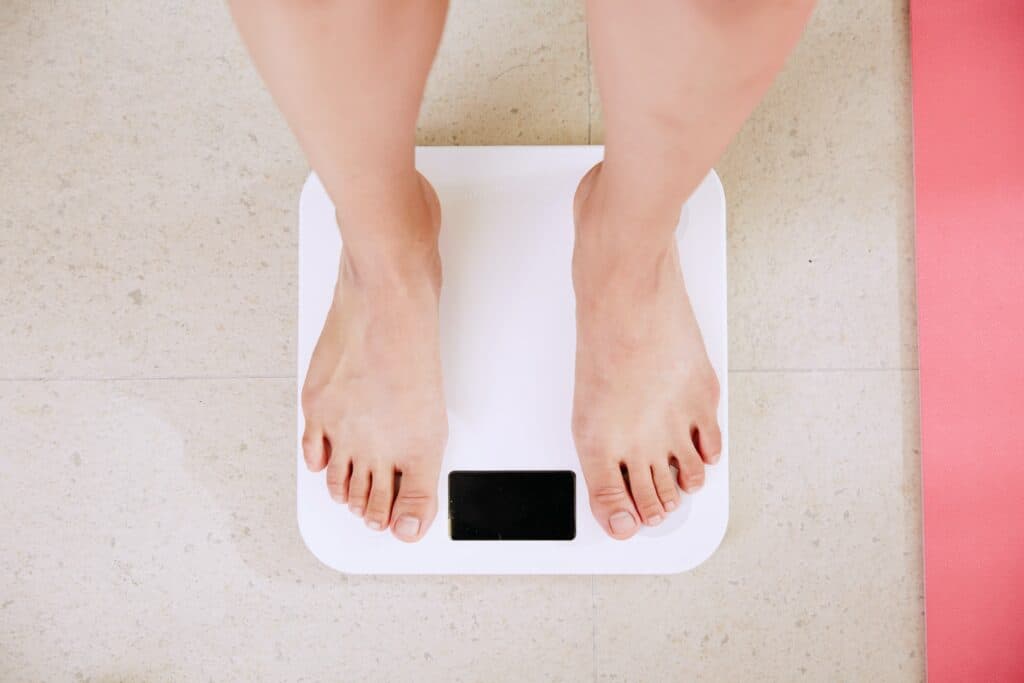Lipoedema is a condition that causes abnormal fat buildup in the legs and sometimes in the arms. It occurs almost exclusively in women and can be painful to touch. Unlike normal weight gain, lipoedema looks and feels different from ordinary fat. Let’s take a look at what lipoedema is, the signs, causes, and how you can treat it.
What is Lipoedema?
Lipoedema mainly affects the hips, buttocks, and legs, but it sometimes affects the arms too. It’s a condition where there is abnormal fat buildup. The condition affects both sides of the body equally. It makes it look like your lower body is out of proportion with the rest of the body.
Lipoedema is different from normal weight gain. The fat deposits can be painful and really impact your day-to-day life. People with lipoedema often have an average upper body, and the bottom half is out of proportion.
The condition comes in several stages. To start, the surface of the skin appears normal, but the fat deposit under the skin is enlarged. As the condition continues, the skin begins to appear uneven and dimpled. In more severe cases, the area may become lumpy and even change shape.
What are the Different Types and Stages of Lipoedema?
Lipoedema is categorised into five different types based on where they occur on the body:
- Type I: This is where the fat deposits are between the hips and belly button. Such fat often covers the buttocks and pelvis area.
- Type II: The fat deposits occur around the pelvis, down to your knees.
- Type III: The fat begins at the pelvis and down to the ankles. A person with type III lipoedema may have a prominent fat cuff at the ankles.
- Type IV: In this situation, the fat deposits spread from the shoulders down to one’s wrists.
- Type V: The fat deposits are predominantly on the calves.
Some people have a combination of different types. The most common combinations are Type II and Type IV or Type III and Type IV. Type V lipoedema is usually rare.
Lipoedema Stages
- Stage 1 lipoedema – you still have smooth skin, but there starts to be a buildup of fat deposits. This could be in the hips, buttocks, around the pelvis, knees, thighs, and ankles.
- Stage 2 – the skin starts to look uneven with indentations in the fat tissue. You can start to see and feel larger amounts of fat tissue.
- Stage 3 – you may see much larger deformations with fat tissue causing large protrusions, especially around the knees and thighs.
- Stage 4 – you can develop lipo-lymphedema, which is where you have both lipoedema and lymphedema and will notice large overhangs of tissue on the arms and/or legs.
There are several stages of the condition, and it can also affect different areas of the body, including the legs, arms, buttocks, and saddlebag region. It could affect one or multiple areas of the body.
What Causes Lipoedema?
The exact cause of lipoedema is unknown. The condition appears to run in families, so scientists believe that genes are involved. There is likely a link to hormones as it can start or worsen at the time of menstruation, pregnancy, and menopause.
Lipoedema almost only affects women. Because of estrogen receptors in white adipose tissue, it’s thought that estrogen is a major factor in the condition. That’s not to say that men can’t get lipoedema, just that it’s more common in women.
While hormones and genes are thought to play a big role in causing lipoma, the precise mechanism behind the condition is poorly understood.
What are Lipoedema Symptoms?
When you have lipoedema, many people describe their legs as being heavy, oversized and swollen. The legs appear to be symmetrically swollen. Unlike regular fat that feels smooth, the fat deposits feel like small nodules, like foam balls in a bag. It can be painful when you nudge or scrape the affected area, even gently.
With lipoedema, your feet and hands aren’t usually affected. So, a typical lipoedema symptom is cuffing, where the swelling stops suddenly at your hands and feet.
Fat also builds up in the thighs, buttocks, and calves. As the pain worsens, it can affect your ability to walk. Most lipoedema patients usually feel embarrassed, anxious or depressed as the lower part of the body grows larger. As fat accumulates, it can block the lymphatic pathway, leading to lymph buildup. The condition is referred to as secondary lymphedema or lipo-lymphedema.
The skin can feel soft and dimpled, similar to cellulite. Other signs and lipoedema symptoms include:
- Feel heavy
- Bruises easily
- Pain and tenderness
- Painful joints
- Excess weight primarily on the legs
- Upper and lower body are completely different sizes
- Small waist with large thighs
- Can lose weight on the top but not bottom part of the body
You may find that your symptoms get worse with:
- Exercise
- Flying
- Hot weather
- Standing for too long
Often, people with lipoedema have tried dieting with no success, which is very frustrating but also a sign that you may need to seek further help. The disease can affect both your mental and physical health, so it’s important that you are aware of the symptoms and speak to your doctor.
What Else Causes Large or Swollen Legs?
Large or swollen legs can be a symptom of other conditions. For instance, if the skin is tight but not painful, it could be a sign of lymphoedema. Lymphoedema is caused by the lymphatic system which helps to drain fluid from tissues and fight infection.
Another cause could be a build-up of fluid which can result in swollen legs, ankles, and feet. This is known as oedema. Generally, lipoedema doesn’t affect your feet, so this could mean it’s something else. For any concerns, you should speak to your GP who can determine your condition and the best course of treatment.

Obesity can also result in swollen legs. In the case of obesity, fat is distributed evenly throughout the body. Regular exercise and a balanced diet are effective in treating obesity. Finally, chronic venous insufficiency can also result in leg swelling. The condition results in the presence of fluid and the absence of fat. In such a case, the skin is itchy and has a brownish discolouration.
Diagnosing Lipoedema
Sometimes it can be a little tricky to diagnose lipoedema. It can be misdiagnosed as weight gain and it’s advised that you exercise more and follow a healthy diet. However, lifestyle changes alone are unlikely to make a big enough impact on the build-up of fat caused by lipoedema.
To diagnose lipoedema, your doctor will perform several tests by looking at:
- The way fat is distributed in the body
- If your swelling is on one side or both sides of the body
- If there is a thickening layer of fat under the skin on the arms or legs
Your doctor will then ask about any bruising, pain, or tenderness you have in the swollen areas. They may also check your blood flow and ask about your diet. Because lipoedema tends to get worse over time, your doctor will usually take measurements to see if there are any changes.
What’s The Difference Between Lipoedema And Lymphoedema
Lipoedema is a chronic condition that can sometimes develop into lymphoedema as it progresses. This is due to the buildup of fat which causes the lymphatic system to stop draining fluids, inflammatory molecules and cell waste products properly from your tissues.
In contrast to lipoedema, with lymphoedema:
- Either the feet or hands are affected.
- The degree of swelling isn’t the same if both arms or hands are affected; swelling on one limb is more severe than on the other.
- Swelling causes fluid to build up in the lymphatic system.
- There is usually an increased risk of developing an infection.
- If the condition is temporary, the swollen skin indents or leaves a pit when you put pressure on it
Lipoedema Treatment UK: What to Expect
The first step of treating lipoedema is getting diagnosed. It’s not always easy to get diagnosed as it’s sometimes mistaken for weight gain. To make a diagnosis, your doctor will look at swelling, distribution of fat and whether the fat layer is thickening. Your doctor will also ask you about bruising, pain, and other symptoms. There is no cure for lipoedema. But several treatments can help you manage the condition, slow it down, and stop it from getting worse.
Wear Compression for Lipoedema
Wearing compression garments won’t help reduce your limbs’ actual size, but it may help decrease pain and discomfort. The compression garment can stop the condition from getting worse.
Compression therapy puts pressure on the affected areas. The compression can also help to smooth out the body shape of the affected limbs. There are different types of compression garments, depending on your individual case. The most important thing is that the compression garments fit well, so it puts enough pressure on the right area.
Increase Physical Activity and Healthy Diet
Eating a healthy diet, regular exercise, and maintaining a healthy weight is essential in managing lipoedema. Extra weight will put stress on your joints. A healthy weight and staying active may help to stop developing a more advanced stage of lipoedema.
Living a healthy lifestyle and staying active will help to maintain a healthy weight. Try taking regular active breaks throughout the day or incorporate low-impact exercises into your routine like swimming or walking.
Lipoedema Liposuction
Liposuction is another way to help treat lipoedema. It can help with reducing symptoms, pain and removing fat. For a lot of patients, liposuction delivers long-lasting results. But it’s important to know that the fatty tissue can come back and start to build up again.
By targeting fat with liposuction, you can surgically remove the fat you have. The fat can build up again, but for many patients, liposuction offers a long-term solution and can greatly improve their quality of life and mobility. Before recommending liposuction, it’s likely that your doctor will suggest non-surgical treatments to make sure that you can’t reduce your symptoms through diet and lifestyle alone.
After liposuction, you will need to wear a compression garment to reduce swelling and apply pressure to the treated areas. Over time, you can stop wearing the compression garment and resume normal activities. You can expect liposuction recovery to take about 6 weeks.
Skincare
Another way to manage the condition is to focus on the skin. The skin around the affected area can be more susceptible to fungal infections and irritations. It’s essential that you keep the skin clean and pat dry to reduce the risk of infection. Make sure to keep your skin clean and moisturise daily to stay hydrated.
Finally, lipoedema can be a very challenging condition that affects your mental health. Looking after yourself and staying positive is important in the treatment of lipoedema.
Living with lipoedema can feel difficult and tough. It can really impact your mobility, confidence, and mental health. By understanding the symptoms and signs of the condition, you can seek help and treatment to manage it and reduce symptoms.
Lipoedema Liposuction UK at The Harley Clinic
To book a consultation with an expert plastic surgeon and discuss your options, please contact the team at the Harley Clinic today.













